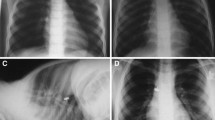Abstract
This study was done to find out modern demographic trends of aspiration and different foreign bodies posing a risk. For this study, 94 patients with suspected foreign body aspiration (FBA) were selected. Detailed history, especially age, suspected Foreign body (FB) and mode of onset were noted and a thorough clinical examination was done. X-ray chest and neck, antero-posterior and lateral view was the only investigation done in all. Rigid bronchoscopy under general anaesthesia was done in all the cases of suspected FBA for diagnostic cum therapeutic purpose. Among 94 patients 70.2% i.e. 66 were within 5 years of age and most were within 2–3 years of age. Rigid bronchoscopy was done in all the cases and foreign body was successfully retrieved in 78.7% of cases. Bronchoscopy was negative in the rest of the cases. The Most common site of lodgment was the right bronchus followed by the left bronchus, the trachea and other sites. Vegetables were the most common FBs as they were found in 26 cases. Whistles from small plastic toys were the single most common FB(15). Other foreign bodies were small plastic and metallic parts, safety pins, jewellery etc. Children under 5 years of age are at greatest risk of FBA. Different vegetables and whistles of low grade toys are the most commonly aspirated FB. Detailed history is most important for diagnosis. X-ray is not a reliable tool for diagnosis. Bronchoscopy should be done whenever a foreign body is suspected in the airway.

Similar content being viewed by others
References
Even L, Heno N et al (2005) Diagnostic evaluation of foreign body aspiration in children: a prospective study. J Pediatr Surg 40(7):1122–1127
Morley RE, Ludmann JP, Moxham JP, Kozak FK, Riding KH (2004) Foreign body aspiration in infants and toddlers: recent trends in British Columbia. J Otolaryngol 33(1):37–41
Sadan N, Raz A, Wolach B (1995) Impact of community educational programme on foreign body aspiration in Israel. Eur J Paediatr 154:859–862
Mathiasen RA, Cruz RM (2005) Asymptomatic near-total airway obstruction by a cylindrical tracheal foreign body. Laryngoscope 115(2):274–277
Mukherjee A, Basu AK, Chakraborty S (2006) Non-resolving pneumonia in a young boy–beware of foreign body aspiration. J Indian Med Assoc 104(3):145–147
Rothmann BF, Boeckman CR (1980) Foreign bodies in the larynx and tracheobrochiiall tree in children. A review of 225 cases. Ann Otol Rhinol Laryngol 89:434–436
Black RE, Choi KJ, Syme WC, Johnson DG, Matlak ME (1984) Bronchoscopic removal of aspirated foreign bodies in children. Am J Surg 148:778–781
Author information
Authors and Affiliations
Corresponding author
Rights and permissions
About this article
Cite this article
Mukherjee, M., Paul, R. Foreign Body Aspiration: Demographic Trends and Foreign Bodies Posing a Risk. Indian J Otolaryngol Head Neck Surg 63, 313–316 (2011). https://doi.org/10.1007/s12070-011-0227-5
Received:
Accepted:
Published:
Issue Date:
DOI: https://doi.org/10.1007/s12070-011-0227-5




